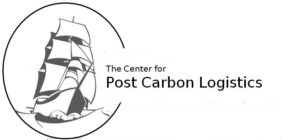Latest Publication
- Sail Freight Second Edition
A publication of:

The Center for Post Carbon Logistics
Sail Freight Second Edition
Editor Steven Woods
Copywrite 2023 The Center for Post Carbon Logistics
This work is licensed under a Creative Commons
Attribution-NonCommercial-NoDerivatives 4.0 International License.This handbook is not a comprehensive guide to Sail Freight
operations, but simply a collection of experience gained recently
during the Sail Freight Revival. It is hoped that this guide will aid in
understanding the functioning of sail freight operations, but relies on
perspective sail freight operators to be experienced sailors. The advice
in this work does not constitute an exhaustive or direct set of
procedures, but points the way to developing your own.
No part of this manual can be used directly without adaptation to
local circumstances, and does not constitute legal, business, investment, or financial advice. - Confrence on Small Scale Inland & Coastal Sail Freight 2022
- Rondout Riverport 2040
A publication of:

The Center for Post Carbon Logistics
Rondout Riverport 2040
© Andrew Willner 2022This work is licensed under a Creative Commons. Attribution-NonCommercial-NoDerivatives 4.0 International License.

Rondout past and future This work does not constitute an exhaustive or direct set of procedures, but points the way to developing your own plans for resilient small ports. No part of this publication can be used directly without adaptation to local circumstances, and does not constitute legal, business, investment, or financial advice.
Rondout Riverport 2040 proposes a pragmatic and prosperous vision for the near future with a transformed port, boasting a shore lined with leading-edge and heritage maritime commerce that profit and engage while allowing for an equitable transition beyond fossil fuels.
Rondout Riverport will offer more capacity, be significantly more compact, and more resilient than the current patchwork of land uses found on today’s waterfront. The mission of tomorrow’s port is the post carbon maritime transport of goods and people up and down the Hudson River and beyond. Riverport is designed to attract shipping, distribution, commerce, food processing, and craft businesses. The result: a regenerative working waterfront — a gateway to the Hudson Valley and world.
The port’s versatility will depend on the linking of its economic opportunities with environmental restoration, sustainable commerce, and training centers. This multi-generational project will also be a source of inspiration for broader long-term action on climate change.
- The Sail Freighter Handbook
A publication of:

The Center for Post Carbon Logistics
The Sail Freighter Handbook
© Steven Woods 2022This work is licensed under a Creative Commons
Attribution-NonCommercial-NoDerivatives 4.0 International License.This handbook is not a comprehensive guide to Sail Freight
operations, but simply a collection of experience gained recently
during the Sail Freight Revival. It is hoped that this guide will aid in
understanding the functioning of sail freight operations, but relies on
perspective sail freight operators to be experienced sailors. The advice
in this work does not constitute an exhaustive or direct set of
procedures, but points the way to developing your own.
No part of this manual can be used directly without adaptation to
local circumstances, and does not constitute legal, business, investment, or financial advice.
Title Page Image courtesy of the University of Washington Freshwater and Marine Image Bank.
Introduction And Scope
This small book isn’t designed to be a complete manual of
everything you need to know about Sail Freight: That would be a
volume of several gross register tons, and completely unreadable.
Instead, this is designed as an introductory How-To of the practical
elements of Sail Freight. Once you have started to understand the
regulations, practicalities, and the basics of navigation, this volume
will begin to be useful. Hopefully, this is the tool you read between
understanding the theory and buying a boat, to clear up the otherwise
difficult portions of making a sail freight business function.
When looking at Sail Freight, just knowing how to sail isn’t
enough. You have to know how to get cargo back and forth to the
docks, how to recruit cargos, be your own broker, and more.
Understanding Coast Guard and state regulations is critical, alongside
many other practical concerns you’ll find mentioned in this booklet.
This tool is designed to help guide you through the practical decisions
necessary to be successful, and isn’t going to help you learn to sail, or
handle cargo, or other challenges. While this may point out gaps
which need to be filled in your knowledge, it is hoped that closing
those gaps before you begin will save a lot of headache, money, and
(possibly) lives, in the long term.
Complete List of Publications
- Sail Freight Second Edition
- Confrence on Small Scale Inland & Coastal Sail Freight 2022
- Rondout Riverport 2040
- The Sail Freighter Handbook

